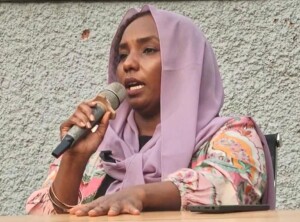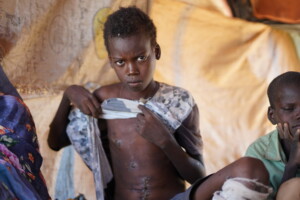Sudan report: over 7,000 protesters seriously injured since Oct 25 coup
The Hadhreen initiative published a documentary report yesterday on the violations against peaceful pro-democracy protesters dating from the October 25, 2021, military coup to August 4 of this year. At least 116 protesters had died at the hands of security forces and over 7000 protesters had reportedly been injured up to August, but real numbers are likely to be higher.
 Protesters carry one of their injured comrades during one of the Marches of the Millions in January (Faiz Abubakr)
Protesters carry one of their injured comrades during one of the Marches of the Millions in January (Faiz Abubakr)
The Hadhreen initiative published a documentary report yesterday on the violations against peaceful pro-democracy protesters dating from the October 25, 2021, military coup to August 4 of this year. At least 116 protesters had died at the hands of security forces and over 7,000 protesters had reportedly been seriously injured up to August, but real numbers are likely to be higher.
The grassroots initiative, which first emerged during the December revolution, has always worked to support injured protesters, especially those who require additional and ongoing medical support.
In the report, called ‘The Real Culprit’, Hadhreen documents the scale of the violations against peaceful protesters by the security forces, under the leadership of the military junta that took power on October 25. It focusses predominantly on severe injuries that required prolonged treatment.
Hadhreen provides statistics on the cases of injured protesters they assisted. They note that they “do not claim that we have treated all the victims of the coup”.
Hadhreen explains that some cases have been missed as not all hospitals had Hadhreen or CCSD field teams and not all those cases were referred to them at a later stage. Those who did not require hospital treatment and injuries treated by first aid teams in the field are usually also not included in CCSD reports.
More protesters were injured or killed in pro-democracy protests after August as well.
According to the CCSD, it is estimated that the number of protesters injured since the coup exceeded 7,000 by August 2022. Hadhreen estimates that over 400 of those were under 18 years of age. 116 protesters were reported to have sadly lost their lives.
'The number of protesters injured since the coup exceeded 7,000 by August 2022'
More than half of those who passed away were between 18 and 25 years old, whilst another 16 per cent were less than 18 years old. Only ten per cent of the martyrs was older than 36.

The report counted injuries per injured body area and per cause of injury.
Severe injuries
In total, 1074 injuries were classified as severe, including 187 under 18 years old. Of those, at least 78 cases were admitted to Intensive Care Units (ICUs), with 18 cases being under 18 years old. At least 46 of them had injuries to the head and neck. Their stays at ICUs ranged from two to 45 days.
21 protesters admitted to ICUs sadly passes away and one protester was diagnosed with permanent reduction of consciousness and will always require continuous medical care at home.
Long-lasting and permanent injuries
At least nine victims sustained varying degrees of permanent or long-lasting paralysis, of which four were minors. Eight victims required extensive rehabilitation treatment outside of Sudan.
Hadhreen counted 14 partial or complete limb amputations accompanied by seven removals spleens or kidneys. 19 victims lost eyesight in at least one of the eyes, of which 12 had to undergo complete eye removals.
Injuries per body area
180 protesters sustained head and neck injuries, of which 50 martyrs passed away. No less than 122 protesters were injured in the chest and 43 passed away as a result.
Many other, sometimes fatal, injuries were reported to the lower limbs and pelvis, the upper limbs, the back, the face, and the abdomen.
The report also lists 98 eye injuries, including the eyesight losses mentioned above.

Injuries by cause
Hadhreen also counted 1,363 injuries caused by firearms, including live bullets, buckshot, and rubber bullets. 103 martyrs passed away as a result and 512 required additional surgical and medical intervention.
Another 3,119 injuries by teargas canisters were reported. These are direct impact injuries, so exclude the impact of the gas itself, although one martyr passed away because of respiratory complications related to tear gas inhalation. At least 259 protesters required additional surgical or medical intervention.
258 stun grenade injuries were recorded, including nine amputations. Another 68 injuries were caused by physical violence and beatings, with three fatal injuries.
65 protesters were rammed or run over by security vehicles and three lost their lives as a result.
Hadhreen’s operations
Hadhreen emerged as a grassroots initiative during the 2018 December revolution that toppled the dictatorship of Omar Al Bashir. The initiative was quick to join the great efforts undertaken by health professionals “to help treat and safe lives of the injured protesters throughout Sudan, and in Khartoum in particular”.
The initiative worked to cover the treatment costs of injured activists, collaborated with hospitals and clinics to make treatment available to more victims, formed an independent medical advisory committee, and supported activists in getting treatment abroad if they required specialist support that was not available in Sudan.
When Al Bashir’s regime finally fell and the military took over in a coup in 2019, the initiative took on its current name and continued to support victims throughout months of violent crackdowns until October 2020 although it rolled back its activities after the formation of two care organisations by victims themselves ensure that the victims’ organisations would have the freedom and space to operate without competition for resources and funding streams.
After the October 25 coup, however, Hadhreen had to reinstate its operations. This time in close collaboration with the Central Committee of Sudanese Doctors (CCSD), which would oversee the initial emergency response. Those requiring additional treatment were referred to Hadhreen, which had renewed its contracts with private health providers and public specialised centres, provided unavailable medicines or equipment, and covered the costs of diagnostic tests.
'Hadhreen reluctantly and sadly announced that it is being forced to cease its operations […] due to the worsening economic situation in Sudan and globally'
In August this year, Hadhreen “reluctantly and sadly announced that it is being forced to cease its operations due to the growing indebtedness to private care providers and the progressive drying out of donations and funding streams due to the worsening economic situation in Sudan and globally and the rising costs of healthcare”.
Hadhreen has handed over the responsibilities to the CCSD “for them to gracefully take on going forward”. They stressed that “despite Hadhreen ceasing operations, we are still actively working to ensure that those injured following the cessation will get as much support and aid possible”.
In the report, Hadhreen stresses that it did not undertake all those monumental efforts singlehandedly but was part of the Lastom Wandakom, 'You are Not Alone', collaboration that included several Sudanese organisations and professional bodies from all around the world, and that “many collective and individual initiatives from Sudan and abroad contributed to provide additional support throughout this long journey”.
“We can’t miss the opportunity to extend our warmest thanks and gratitude to all the men, women, and children of the great Sudanese public, in Sudan and all over the world for all their support and never-ending sacrifices,” the initiative writes in their closing statement.











 and then
and then